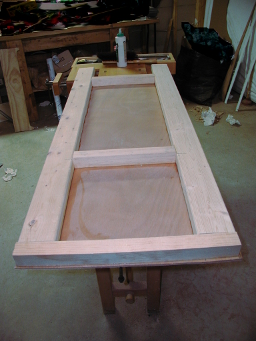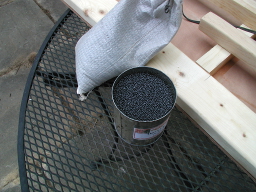
Once again lots of spring clamps make life easier. I made a framework of 2x4's and 2x2's and a bottom skin of 1/4" okoume. Since all surfaces were square I used Titebond III waterproof glue instead of epoxy. The center bit of wood was held in place by 25 lbs of lead.

The compartment nearest the camera will be filled with lead. Bolger's design calls for the bottom edge to be open, but I prefer to have a thick piece of wood there to isolate the lead from the environment. It will also make casting the lead easier.
Originally I had been thinking of cold casting the lead. That is, mixing a slurry of lead shot and epoxy and pouring that into the space. That was mainly to avoid the need to get equipment to melt lead, as well as concern about the hot lead burning through the okoume. However, I learned from master boatbuilder Geoff Kerr that he poured PocketShip's keel directly into 1/4"okoume with no trouble, and that was a lot more lead. I also got hold of a used electric crucible for a very reasonable price, so I decide to go with casting molten lead.

The steel table gives even support for the keel and the 100 lbs of lead that will fill the smaller compartment. The first step was to level the table and keel to assure an even fill. The leveling was done in both directions.

This is about 12 lbs of reclaimed lead shot. So a bit over 8 cans used to cast the keel. Not only was it cheaper than other types of lead, but by using reclaimed lead I was recyling a hazardous substance, rather than introducing a new stream into the environment.

That'd be a really good title for a play or something. Here's 10 lbs of lead in the electric crucible, heating up to melt. The lead formed a fair bit of slag as it melted.

The can has the next refill, the bag is the refill for the can and the bonsai saw is to open the bags.
In theory, once the lead was molten, lifting the handle was supposed to allow the lead to flow into the mold. However, the thin trickle of lead hitting the cool air caused it to harden almost immediately. The result was a spire, sort of like those sand castles where you drip the wet sand onto the towers. It was not a nice flat pour. I ended up just picking up the crucible and pouring the lead into the keel.
Which brings us to safety. First, lead is a toxic chemical. It can poison you, your family, your pets. If you spill it and don't clean it all up, it will get into the environment. It will get into the grass and other plants. Animals will eat it, get eaten by predators, etc. If you spill it near a garden, it will get into the food chain. You need to wash your hands after handling it. Never let it near children and never let children near it. It damages the nervous system, especially in children. And this is while it's a cold solid.
Lead melts at over 600 degrees. When molten it gives off toxic fumes. If it spills on your skin, it will cause a very painful and damaging burn because it will burn down into the skin, cool off enough to harden and then stay there hot enough to keep burning. If water gets into the molten lead, it will explode into steam sending molten lead flying everywhere.
The absolute minimum precautions are eye protection, leather gloves, full pants, long sleeved shirt and solid leather footwear. You want any spills to cool off enough to harden before they finish burning through to your skin. A respirator is an excellent idea, too. Alway work in a secured, well-ventilated area.
Always properly dispose of all slag, containers, contaminated clothing, etc. Our county has collections for hazardous materials and I was able to take all my lead-contaminated wastes there for free.
Finally, pay attention and don't be distracted by anything. That why you won't see any photos of any actual casting. I was too busy being safe to take any.